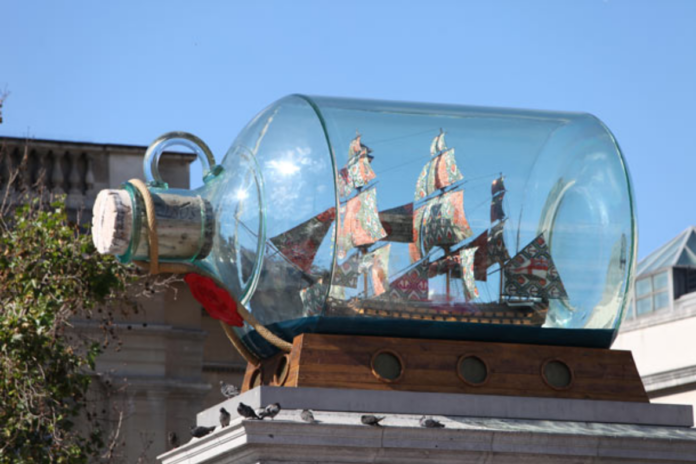Later this month, we will release Eddie Chambers’ “Black Artists in British Art: A History from 1950 to the Present.” In the meantime, enjoy this exclusive excerpt.
Examining the experiences and creations of Black British painters, sculptors, photographers, mixed-media installation artists, and performance artists from 1950 to the present, Chambers’ “Black Artists in British Art” provides unparalleled insight into numerous social, political, historical, philosophical, cultural, and artistic contexts.
Historically, Black artists have been overlooked or omitted from scholarly British art discussions. Therefore, “Black Artists in British Art” is essential to establish a narrative where Black artists are rightfully accepted within British art history.
This passage, which is an extract from the book’s foreword, examines how two Black British artists have challenged the portrayal of Horatio Nelson. Despite the separation of two centuries, he remains one of Britain’s revered figures.
Also Read: Extract: Women Of Karantina
John Thomas Smith’s Portrayal Of London
In 1815, John Thomas Smith, the Keeper of Prints at the British Museum, created a remarkable series of prints in London titled “Etchings Of Remarkable Beggars, Itinerant Traders, And Other Persons Of Notoriety In London And Its Environs.” Within a year, the prints were later compiled into a book titled “Vagabondiana or Anecdotes of Mendicant Wanderers Through the Streets of London, with Portraits of the Most Remarkable Drawn From the Life” and published. Smith’s etchings were among the earliest endeavors to depict London’s impoverished population in a manner that avoided caricature. Instead, they aimed to capture the personalities of the subjects as well as the hardships they endured.
In summary, the etchings offered a vivid portrayal of various street characters, including blind beggars, individuals with disabilities, and impoverished individuals, all observed objectively. Simon Houfe, the writer, noted that Smith recognized the importance of depicting the realities of blindness, beggary, and poverty rather than merely representing stereotypes of them.
However, one may view Houfe’s assessment as somewhat generous, as Smith himself acknowledged that he aimed to provide likenesses of the most remarkable beggars along with details of their habits, primarily for the entertainment of those who had encountered them over the years.
John Thomas Smith’s Critical Examination Of Beggary In London
In his work “Vagabondiana,” John Thomas Smith provided a captivating analysis of contemporary beggary in London. He asserted that the situation had become dire in recent years, necessitating more proactive intervention from the legislature.
Smith appeared determined to dispel any perception of liberalism or sentimentality on his part and any notion of empathy between the artist and the subject. He expressed his belief that the deception practiced by both idle and able-bodied individuals was so widespread and cunning that distinguishing genuine cases needing charity from impostors was exceedingly challenging.
Smith suggested that governmental efforts to eradicate beggary could lead to the disappearance of certain intriguing characters, either by compelling them to seek employment or by taking advantage of the assistance provided by workhouses.
Depiction Of Joseph Johnson, A Black Sailor, In “Vagabondiana”
One particularly intriguing etching in the series portrays Joseph Johnson, a black sailor, wearing a cap adorned with a model of the ship Nelson. Referred to as “Black Joe,” he had served as a seaman in the Merchant Navy until being injured and subsequently discharged.
During the period when John Thomas Smith documented characters like Johnson on the streets of London, the city’s homeless and unemployed population swelled significantly due to the large number of military personnel demobilized following the conclusion of the Napoleonic Wars.
Consequently, Johnson’s decline in fortune was emblematic of this trend. Reports indicated that he did not qualify for a seaman’s pension and could not access other forms of assistance, such as parish relief, because he was not a British citizen by birth.
Survival Strategies Of Joseph Johnson, The Busking Black Sailor
In order to survive, Joseph Johnson resorted to busking, utilizing his unique headwear—a model of the military vessel Nelson—to attract attention. For centuries, London has been home to a significant Black population, and the scant information available about “Black Joe” sheds light on how free Black individuals were integrated into the capital two centuries ago.
By crafting a model of the Nelson, Johnson communicated his background as a seaman and employed a symbol of one of the most renowned and celebrated military ships of its era. Construction of the Nelson began at the Woolwich dockyard in 1809, and the ship was launched in July 1814. It launched in the presence of the Royal Family and a vast audience estimated to be over 20,000 people.
Joseph Johnson’s depiction of the ship HMS Nelson honored one of Britain’s esteemed heroes, Horatio Nelson. Nelson’s renown was solidified when, under his command, the Royal Navy emerged victorious against the combined fleets of the French and Spanish Navies at the Battle of Trafalgar—a pivotal moment in the Napoleonic Wars, ultimately concluding in 1815. Nelson’s death during the Battle of Trafalgar in October 1805 elevated him to arguably Britain’s greatest admiral.
Portrayal Of Nelson By Johnson And Observations by John Thomas Smith
Johnson’s portrayal of the Nelson was notably accurate, as the ship was a full-rigged vessel with three masts, all square-rigged, mirroring Johnson’s distinctive headwear. John Thomas Smith observed that when Johnson wore the model on his cap, he could simulate the motion of the sea with a bow or a supplicating gesture toward a drawing-room window.
Smith’s etching of Johnson depicts a Black man holding a walking stick in one hand and a hat in the other, presumably to collect money while busking. In discussing Black beggars in London, Smith asserted that both Black individuals and those lacking sight often elicited compassion from passersby.
Black Artists’ Celebrations Of Nelson’s Warships
In John Thomas Smith’s portrayal of Joseph Johnson, we may be witnessing one of the earliest documented instances of a Black British artist, albeit in this case as a sculptor. Two hundred years later, another Black artist, if we may consider Johnson as such, embarked on a project that celebrated another renowned warship associated with Nelson.
London-born, Nigeria-raised Yinka Shonibare unveiled a Fourth Plinth sculpture in May 2010, where he applied his distinctive faux African fabric treatment to a scale model of the warship most closely linked to Nelson. Nelson, one of Britain’s greatest imperial heroes, stands revered. His iconic statue is just a short distance from where Shonibare’s commission was at the center of Trafalgar Square in London.
Media Coverage Of The Commissioned Artwork
Michael McCarthy, writing for The Independent newspaper, exemplified the extensive media attention the commission received by stating:
Trafalgar Square, named in commemoration of the 1805 naval battle, now features a significant addition on its renowned fourth plinth: “Nelson’s Ship in a Bottle.” This artwork, unveiled recently, is a scaled-down replica of HMS Victory, the flagship of Admiral Horatio Nelson. Nelson’s victory at Trafalgar over the French and Spanish fleets marked a pivotal moment in the Napoleonic wars.
Crafted by prominent Anglo-Nigerian artist Yinka Shonibare, the installation raises intriguing questions. Encased within its 4.7-meter by 2.8-meter bottle, the model ship boasts 37 large sails crafted from vividly patterned African fabric. Is this piece a celebration of British historical dominance and triumph, or does it subtly challenge and undermine these narratives?
Also Read: Signature Strikes: A Necessary Evil?


